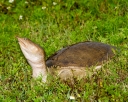Smooth Softshell Turtle (Apalone mutica)
Description: The smooth softshell turtle has an anapsid skull. This kind of skull is present among the earliest reptiles and is retained by turtles today. The anapsid skull lacks openings behind the orbits. The smooth softshell turtle has a smooth, flexible and leather like carapace that is covered by skin instead of the hard scutes commonly observed in other turtle species. The plastron is light (white or gray) with no markings, and the underlying bones are visible. Smooth softshell turtles have a tubular snout with round nostrils./
Habitat: Both subspecies of A. mutica are typically found in medium to large unpolluted rivers with moderate to fast currents, but are also found in standing water bodies like lakes, ponds and marshes. They prefer water with sand or mud bottoms, without rocky areas or dense vegetation. Sandbanks must also be present.
Range: A. mutica is native to North America. It is distributed throughout the central and southcentral United States as its geographic range extends from western Pennsylvania to New Mexico and south to the Florida panhandle. Smooth softshells turtles inhabit the Mississippi River drainage from Louisiana up to North Dakota and Pennsylvania, as well as the Colorado, Brazos, Sabine, and Pearl, Alabama and Escambia river systems. Two subspecies of A. mutica have been identified. The midland smooth softshell, Apalone mutica mutica, is found throughout the central United States. The other subspecies, Apalone mutica calvata, is found ranging from Louisiana to the panhandle of Florida.
Diet: The smooth softshell turtle is mostly carnivorous, eating aquatic insects, crayfish, fish and amphibians. Although primarily carnivorous, it sometimes resorts to eating vegetation such as algae, vegetables, fruits, and nuts.
Reproduction: Breeding of the smooth softshell turtle occurs from April to June. The mating system utilized by these turtles is polygyny, meaning that males will mate with more than one female. Males actively seek out females by approaching other adults. If the other party is male or a non-receptive female, aggression may be displayed. However, if the other party is a receptive female, she remains passive to the advancements of the males. Copulation usually occurs in deep pools as the male mounts the female. The nesting period is usually from May to July as females only lay eggs once a year. During this period, adult females of A. mutica lay clutches of 3 to 28 eggs not more than 330 feet from water in sandy areas. Eggs generally hatch 8 to 12 weeks later with the highest frequency of hatching being between August and September. Hatchlings average a weight of 0.19 ounces and have a carapace length of 1.6 inches. Male smooth softshell turtles become sexually mature during their fourth year and females become sexually mature during their ninth year.
Female turtles offer prenatal care for their offspring. They produce high levels of non-polar lipids that provide energy for their growing embryos. This energy is more than enough to keep the embryos alive. The high concentration of lipids also offer an advantage at birth as it acts as a food source until they hatchlings become mature enough to commence feeding. This type of care is also known as parental investment in embryogenesis. However, after hatching no physical parental care is given.
Status: Currently, the smooth softshell turtle is considered a species of least conservation concern. However, the species is still facing some wide-ranged threats. These threats include habitat degradation, harvesting for food, and an increase in human disturbances at nesting sites. Additionally, due to its skin's high rate of gas exchange, it is very susceptible to polluted waters. As a result of all of these factors, the smooth softshell turtle has been listed as a species of special concern in Minnesota and Wisconsin.
Subspecies: Two in our range
This article uses material from the Wikipedia article "Smooth Softshell Turtle", which is released under the Creative Commons Attribution-Share-Alike License 3.0. Content may have been omitted from the original, but no content has been changed or extended.
|







